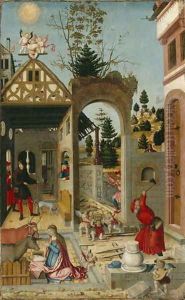Wilhelm Stetter Paintings
Wilhelm Stetter was a German artist known for his contributions to post-war European art, with a career that spanned several decades of the 20th century. Born in 1923 in Germany, Stetter grew up during a period of immense social and political turmoil, which later influenced his artistic direction and thematic choices. Following the end of World War II, he was part of a generation of artists who sought to redefine German art and culture, moving away from the shadow of the war and the preceding Nazi regime.
Stetter's early works were characterized by their exploration of human emotion and the condition of post-war society in Germany. He experimented with various mediums, including painting, drawing, and printmaking, demonstrating a versatile approach to art-making. His style evolved over the years, initially influenced by Expressionism, with its emphasis on emotional expression and the use of bold colors and dramatic brushwork. However, as his career progressed, Stetter began to incorporate elements of abstraction into his work, reflecting the broader trends in European art at the time.
Throughout the 1950s and 1960s, Stetter became increasingly involved in the international art scene. He participated in numerous exhibitions across Europe and gained recognition for his unique blend of expressionistic and abstract tendencies. His works from this period often dealt with themes of memory, loss, and the search for identity in the aftermath of war, resonating with audiences who were grappling with similar issues.
In addition to his artistic practice, Stetter was also an influential teacher and mentor to younger artists. He spent several years teaching at various art schools in Germany, where he emphasized the importance of experimentation and individual expression. His commitment to education and his contributions to the development of post-war German art left a lasting legacy.
Wilhelm Stetter continued to create art until his death in 1998. Over the course of his career, he witnessed and responded to significant changes in the world around him, from the devastation of World War II to the challenges and opportunities of the post-war era. His body of work stands as a testament to the resilience of the human spirit and the power of art to reflect and shape our understanding of the world.

